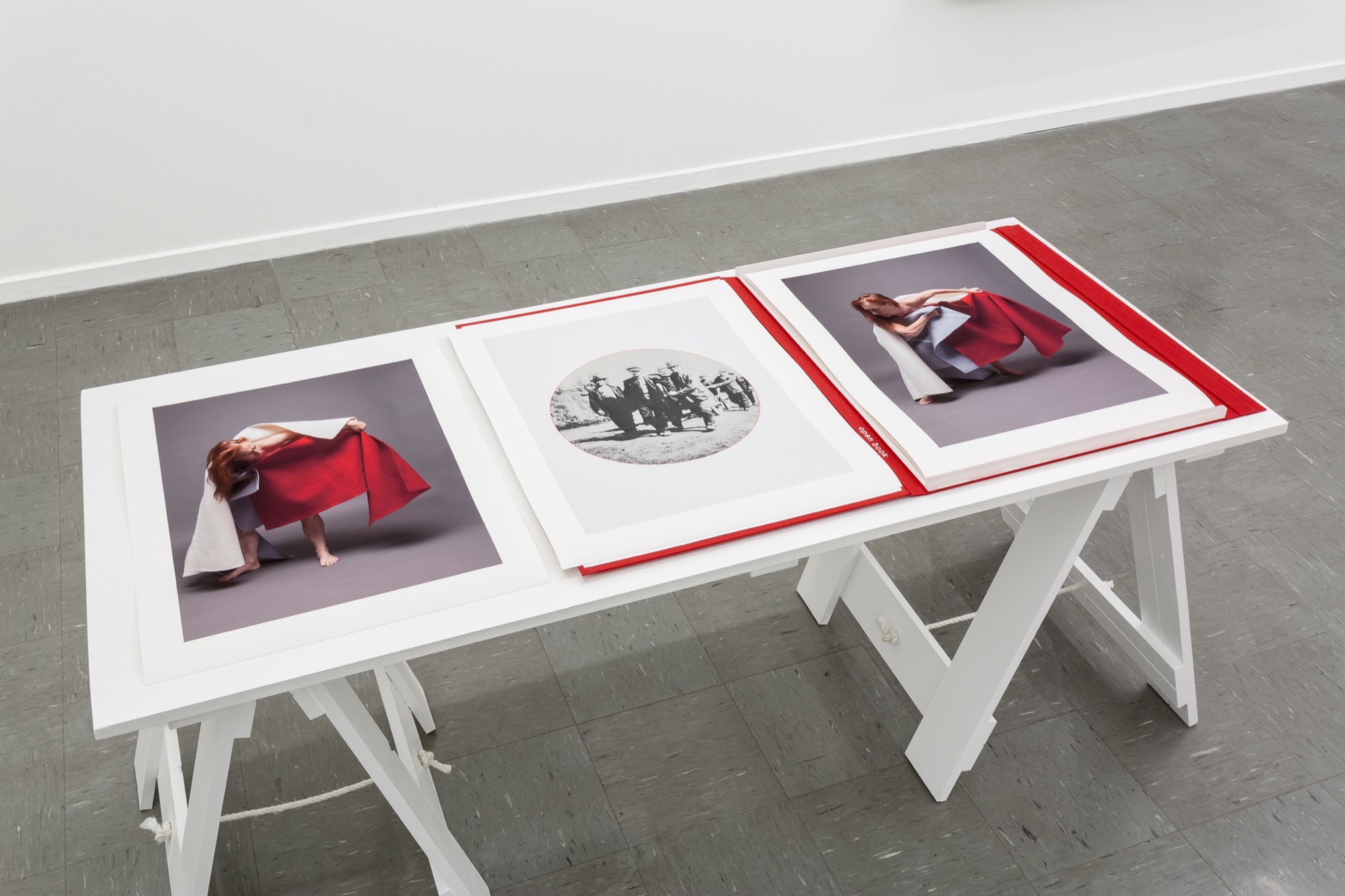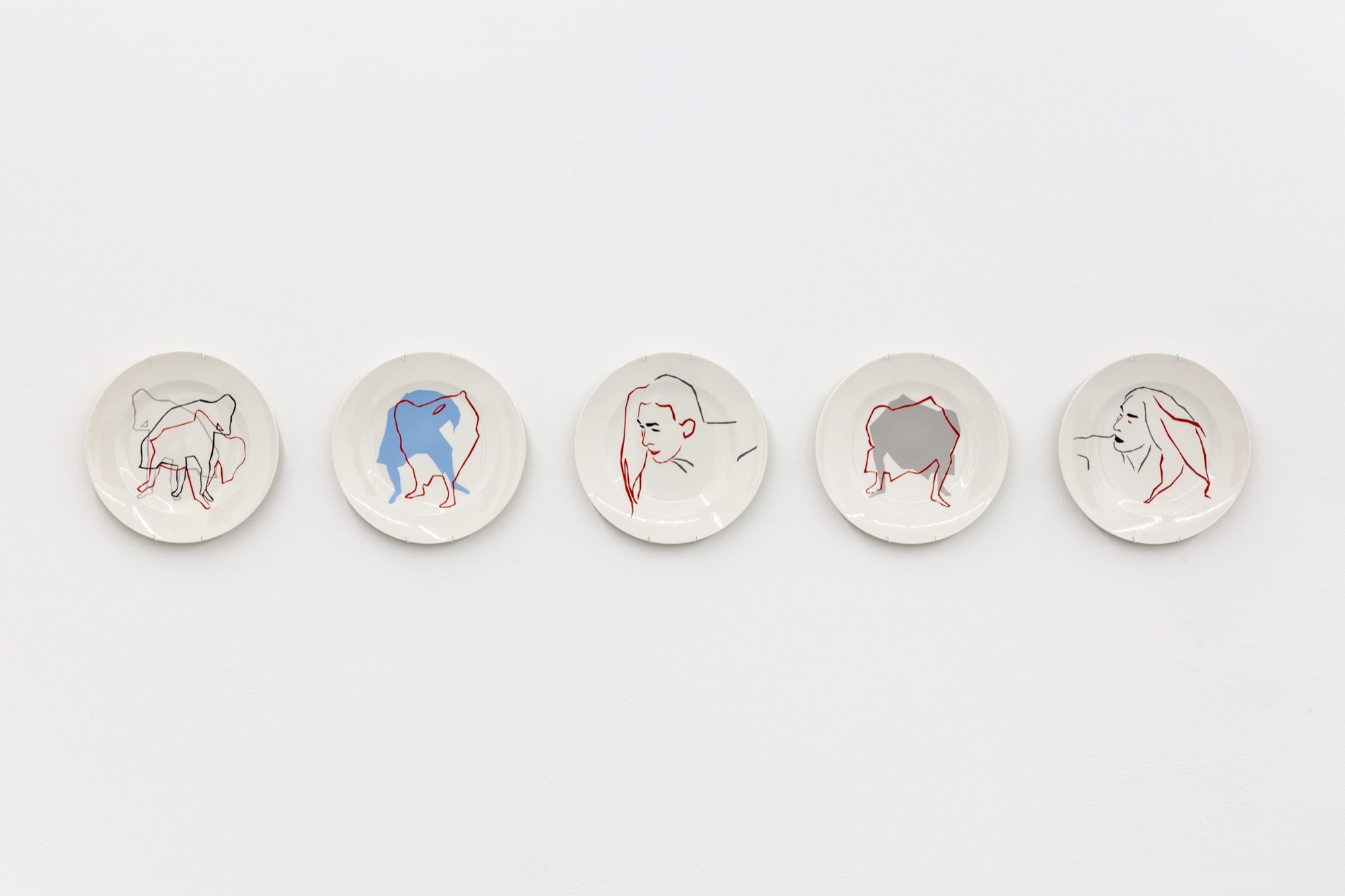Anne Ferran: White Against Red
Giles Fielke
Six large photographs of the dancer and choreographer Ervi Sirén hang from metal brackets near the ceiling of Sutton gallery. Like banners they are suspended in the bright space of the old C.V. Fashions building in Brunswick Street, Fitzroy. They are all the same size and weighted by heavy dowels sewn into the ends of the canvas bolts onto which the images have been printed. Sirén wraps herself in different lengths of felt—she is otherwise naked—and her long red hair flows across her face while her body carries the thick bundles coloured red, white and cerulean blue on grey. There is a martial flavor to these works, some images seem to mark out a montage sequence of gestures, although this is an obvious association to make initially. On a trestle-table sits a series of prints bound in red cloth. The Open Book is viewed with the strict assistance of a gloved gallery attendant, and therefore remains closed for the most part. There are conditions for these photographs, and that implies their viewing may have implications.
Ferran takes her work seriously. The Open Book contains a cropped selection of archival images of prison camps located on the island fortress of Suomenlinna, Finland, interspersed with the digital shots of Sirén taken by Ferran in a bare studio. This is where Ferran has recently undertaken a residency, and of course the significance of working and living in the former military garrison was haunting, overpowering even. Ferran’s work is concerned with shedding something, a burden—the nightmare of history perhaps—by capturing the images like a medium who materialises psychic disturbances. Spirit photography is too easily given as a comparison. A séance without the ectoplasm, perhaps. On the eastern wall a series of medium-sized gloss white ceramic dinner plates reiterate the photo’s dominant colours and gently abstracts the habitually human shapes made by Sirén’s figure. Through simple lines painted to a design formula they are close to approaching the commerce signified by a fine set of crockery off which one would never dare to eat.

The industrial installation of the large prints, hung by wire from aluminium brackets, initially struck me as odd when contrasted with the show’s contents; this mode of display seems more in tune with a current tendency to thrust work towards the viewer, rather than seek to draw our gaze into the image, through some established framing device. But the subtle mix of industrial and digital processes with historical forms begins to appear as central to the work when considered as a trajectory that is traceable in Ferran’s career for the last few decades. The Helsinski International Artist Program (HIAP) is listed on the AusCo website; it highlights the professional opportunities offered to antipodean artists to live and work in the Baltic region. There seems to me to be a question over the production and commission of nationally engaged work at a time of increased anti-immigrant sentiment and a growing anxiety over sovereignty from regressive “Western” governments. Hesitant gestures from artists have materialised in the installations of contemporary art. It is visible in Helen Johnson’s recent paintings, for example, which take a similar form to Ferran’s “off” the wall works—as if attempting to float free of the state apparatuses that finance and administer the work, which is expected to be critical of the state in some manageable way. Has canvas become the place for airing the dirty laundry?
Since 1984 Anne Ferran has held a solo exhibition every other year, often more than one. Seven works from her first series of thirteen achingly intimate black and white portraits of her daughter and her daughter’s friends, Carnal knowledge, entered the collection of the Art Gallery of NSW two years after its debut. Echoing D.W. Winnicott’s reasons for maternal hatred for her child—”she mustn’t eat him or trade in sex with him”—Ferran’s work has complicated feminine identity in ways not often seen in Australian art. In 2014 and 2015 a survey of more than three decades of her work was held on both the east and west coasts of Australia, with catalogue essays by Susan Best and Thierry de Duve. Geoffrey Batchen has compared her work to Pre-Raphaelite photographers Julia Margaret Cameron and Lady Hawarden. Yet Ferran’s work has not yet found its way into the Australian art vernacular as perhaps it should have. A comparison could be made with the trajectory of another photographer of human figures, Bill Henson, who is younger than Ferran but who began exhibiting his work nearly a decade earlier, and hasn’t changed much about his photographic formula of exacerbated chiaroscuro since the mid-1970s. Ferran turned 35 before she held her first solo show.

Photography has always been about performance. Unlike painting, which sought to incorporate movement, it has of necessity tracked the existing conditions for the production of the print, sometimes at the cost of formal coherence. There is no vulgar formalism in photography; rather, it follows an evidential paradigm, which privileges the clues and markers which are exposed in the process. One work in particular has stuck out for more than one reviewer in Ferran’s career, an untitled silver gelatin print of a white cap, perhaps trumping Henson’s use of light and dark and at the same time prefiguring Christian Thompson’s highly-regarded Australian Graffiti series (2007). Now ‘off the wall’, and wedded to the archival practices necessary for the digital administration of bodies, Ferran’s artistic gambit is to seek out what is left of the life that is not made “bare” by its governance. More contemporaneously perhaps David Hammons’ In the Hood, from 1993, and recently on show at the New Museum’s time-capsule exhibition, NYC 1993, could be constructively compared to Ferran’s Soft Caps series (1995), which symbolises the real Gilead of subjugation and colonial empire more so than it does street culture liberalism and active-wear. Importantly, however, it’s the immanent failings of both works that slowly seep out of the exhibition of something as seemingly facile as headwear. White Against Red now appears as something of a continuation in this guise, as related also to her series 1-38, of photographs of anonymous women taken in a Sydney psychiatric hospital in 1948. The maternal instinct that Ferran has drawn upon repeatedly here shifts register to address imperial power after the fact.
One of the great works of art made at the beginning of this century was the film by Alexander Sokurov, Russian Ark (2002). Shot on High-Definition Video in the Hermitage Museum, St Petersburg, the film is a single 96-minute take, meticulously choreographed through the Winter Palace and narrated by the director who voices the writings of “the European” (the French aristocrat and erstwhile travel-writer of the Restoration, the Marquis de Custine). Recently I’ve been reading about Bertolt Brecht’s Kriegsfibel, a “war primer” made during his period of exile. Georges Didi-Huberman’s reflections on institutional images, and images against institutional power, seek to suggest the distance required to understand the position they must take, as their contibution to the montage of history. Europe, as an image, is what is at stake. The outcome of her residency on the military outposts of Finland, Ferran’s series is dedicated to a small group of porcelain plates that are a tiny part of the Hermitage Collection, now safe in the Winter Palace. But Sokurov’s denial of the Brechtian rupture, his film’s lack of any montage “cut”, ushers in the condition we now know as a disorienting flow of continuous images that we can only imagine will remain unabated from here until eternity. Ferran’s photography is not a montage, in this sense; it is a series of equivalents, as a catalogue of gestures can only ever be.

Colour then becomes the final gesture towards the regimented image of the military uniform, the tough tangle of felt. This is a nostalgia for a time before camouflage, invisibility, and non-linear warfare was the standard approach to conflict, where identifiable sides could be seen as standing clearly opposed to one another, white against red and vice-versa, where the terms of engagement where still adhered to like some gentleman’s agreement that no one important would get hurt. The empty formalities of the regalia seem to reinforce the “end-of-history” stereotype, that once important institutions would survive only as ceremonial gestures. It seems important to note, however, that the seemingly redundant monarchies are only sublimated by new forms of power, the lifetime rule of Vladimir Putin as the president king, perhaps, or the inherent feudalism of our financier lords.
Otherwise these images reflect the labour of carrying, and casting off our mortal load. Woman as prisoner, soldier as peasant, artist as subject. At certain points Sirén’s body resembles the women in Millet’s Gleaners. In Russian Ark, “the European” wonders aloud: “why would you try to repeat the same mistakes as Europe?” Ferran’s stated interest in the institutionalised bodies of those from the past—to serve, or to be closeted by power—suggests our contemporary may be just as marked by those older forms. We all have to eat, don’t we?
Giles Fielke is a writer and musician working at Monash University and the University of Melbourne. He is the Business Manager of the AAANZ.


